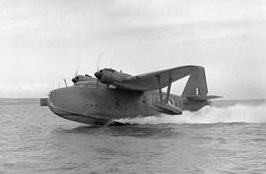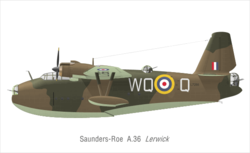Saro Lerwick Video - Picture

|
|
Saro A.36 Lerwick

Picture - Lerwick L7265, ‘WQ-Q’ of 209 Squadron. Taking off from Loch Ryan, March 1941
Role: Flying boat
Manufacturer: Saunders-Roe
First flight: November 1938
Introduced: 1940
Retired: 1941
Primary users: RAF
RCAF
Number built: 21
The Saunders-Roe A.36 Lerwick was a British flying boat built by the Saunders Roe Limited (Saro). It was intended to serve alongside the Short Sunderland in the Royal Air Force's Coastal Command, but it was a flawed design and only a small number were built. They had a poor service record and a high accident rate - out of 21 aircraft, 10 were lost to accidents and one lost for unknown reasons.
Design and development
Air Ministry Specification R.1/36 was issued in March 1936 to several companies that had experience in building flying boats. The specification was for a flying boat to replace the Royal Air Force's Saro London, Supermarine Stranraer and Short Singapore biplane flying boats, in the anti-submarine, convoy escort and reconnaissance roles.
An order was placed for a prototype of Blackburn's radical response to the specification - the Blackburn B-20 - but this would only be delivered in 1940. Meanwhile, a contract was issued in June 1937 to buy 21 of Saunders-Roe's proposed aircraft - the S.36 Lerwick - even though this only existed on paper. The Lerwick was a compact twin-engined, high-winged monoplane of all-metal construction. It had a conventional flying boat hull with a planing bottom and two stabilising floats carried under the wings on long struts. It was powered by two Bristol Hercules engines and initially had twin vertical stabilisers and rudders. For defense, the Lerwick was equipped with three powered Gun turrets. The nose turret had a single Vickers K gun; the other two had Browning machine guns - two guns in the FN.8 turret in the dorsal position and four in the Nash & Thomson FN4.A turret at the tail. The offensive weapons - 2000 lb (900 kg) of bombs or depth charges - were carried in two streamlined nacelles behind the engines.
The first three aircraft were used as prototypes, with the first being launched on 31 October 1938 after numerous delays during design and construction. The Lerwick was immediately found to be unstable, both aerodynamically and on the water, and not suited to "hands off" flying, a major problem in an aircraft designed for long-range patrols. Numerous adjustments, including the addition of a greatly enlarged single vertical tail unit and increasing the wing incidence, failed to remedy its undesirable characteristics, which included a vicious stall and unsatisfactory rates of roll and yaw. In service, several aircraft would be lost because of wing floats breaking off, suggesting this was a structural weakness. Persistent problems with the aircraft's hydraulics would see the bomb doors sometimes dropping open during flight
On one engine, the Lerwick could not maintain height, nor could it maintain a constant heading as the controls couldn't counter the torque of a single engine on maximum power. Thus, an engine failure would inevitably see the aircraft flying in slowly descending circles. On one occasion, the loss of an engine forced a Lerwick to make an emergency landing in the Caledonian Canal. The aircraft was then towed to Oban at the end of a string of coal barges.
Service
In the summer of 1939, four Lerwicks were allocated to 240 Squadron. But by October, the squadron had stopped flying them and reverted to its older and slower Saro London flying boats. The Lerwick programme was cancelled on the 24 October, but restarted on 1 November. In December 1939, Air Vice-Marshal Sholto Douglas recommended the Lerwicks be scrapped and Saunders-Roe put to building Short Sunderlands, but the production changeover would have taken months and, with the start of World War II, aircraft were urgently required.

Picture - Lerwick in the markings of 209 squadron
Production continued and the type entered service with 209 Squadron based at Oban in 1940, replacing Short Singapores. The squadron soon began losing aircraft to accidents. During the service with 209 Squadron, all the Lerwicks were grounded twice for urgent safety modifications; on only two occasions were U-boats ever attacked by a Lerwick and neither one of the submarines was damaged.
In April 1941, 209 Squadron began receiving PBY Catalinas. The last of a total of 21 Lerwicks was delivered in May, but the type was withdrawn from front-line service in the same month. Most of the remaining Lerwicks were transferred to Number 4 (Coastal) Operational Training Unit at Invergordon; three were sent to 240 Squadron for service trials at the highly-secret Marine Aircraft Experimental Establishment at Helensburgh.
In the Summer of 1942, the Lerwicks were briefly returned to service for the purpose of operational training with 422 Squadron and 423 Squadron, Royal Canadian Air Force, based at Loch Erne. By the end of 1942 the type had been declared obsolete; by early 1943, the survivors had been scrapped.
Operators
Canada
Royal Canadian Air Force
No. 422 Squadron RCAF
No. 423 Squadron RCAF
United Kingdom
Royal Air Force
No. 209 Squadron RAF: 1939-1941
No. 240 Squadron RAF : Three Lerwicks used for service trials.
No. 4 (Coastal) Operational Training Unit: 1941
Operational Losses
Specifications (Saro Lerwick)
General characteristics
Crew: 6
Length: 63 ft 7 in (19.4 m)
Wingspan: 80 ft 10 in (24.7 m)
Height: 20 ft 0 in (6.1 m)
Wing area: 845 ft² (78.5 m²)
Loaded weight: 28,400 lb (12,880 kg)
Max takeoff weight: 33,200 lb (15,060 kg)
Powerplant: 2x— Bristol Hercules II radial engine, 1,375 hp (1,030 kW) each
Performance
Maximum speed: 214 mph (344 km/h) at 6,250 ft (1,900 m)
Range: 1,540 miles (2,478 km)
Service ceiling: 14,000 ft (4,270 m)
Rate of climb: 880 ft/min (4.50 m/s)
Armament
Guns: One 0.303 in (7.7 mm) Vickers K gun (nose) and six x— 0.303 in (7.7 mm) Browning machine guns (dorsal [2] & tail [4])
Bombs: 2,000 lb (900 kg) of bombs or depth charges
Comparable aircraft
PBY Catalina
Short Sunderland
Dornier Do 24
Bibliography
Bowyer, Chaz. Coastal Command at War. Sheperton, Surrey, UK: Ian Allan Ltd., 1979. ISBN 0-7110-0980-5. (p. 30.)
Bowyer, Michael J.F. Aircraft for the Few: The RAF's Fighters and Bombers in 1940. Sparkford, near Yeovil, Somerset, UK: Patrick Stephens Ltd., 1991. ISBN 1-85260-040-3. (pp. 148-151.)
Green, William. War Planes of the Second World War, Volume Five: Flying Boats. London: Macdonald & Co. (Publishers) Ltd., 1962 (Fifth impression 1972). ISBN 0-356-01449-5. (pp. 84-87.)
London, Peter. British Flying Boats. Sutton Publishers Ltd. 2003. ISBN 0-7509-2695-3
London, Peter. Saunders and Saro Aircraft Since 1917. London: Putnam (Conway Maritime Press), London, 1988. ISBN 0-85177-814-3.
March, Daniel J. British Warplanes of World War II: Combat Aircraft of the RAf and Fleet AIr Arm, 1939-1945. Hoo, nr Rochester, Kent, UK: Aerospace Publishing Ltd., 1998. ISBN 1-84013-391-0. (p. 191.)
Mondey, David. The Hamlyn Concise Guide to British Aircraft of World War II. Hamlyn (publishers),1982 (republished 1994 by Chancellor Press, reprinted 2002). ISBN 1-85152-668-4. (p. 181.)
Saro Lerwick Pictures
More airplane videos.
Source: WikiPedia